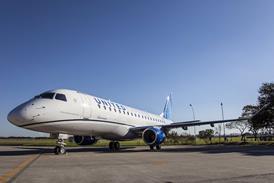Have you always been interested in aviation?
My love of aviation came at a young age when I attended my first air show. I sat in the shade under the wing of a Lockheed Constellation and was hooked. By the age of 16, I had my first flying lesson in a small piston aircraft. It was love at first flight.
Tell us about your qualifications and career to date
I was originally on the engineering track at my high school and went on to study business aviation management at Auburn University, Alabama. I then earned an MBA at Embry-Riddle Aeronautical University. Following graduation, I worked at Sky Harbour airport in Phoenix on a two-year airport management rotation.
While I was doing everything from operations to PR at the airport, I couldn’t help but wonder what was happening across the north runway and curiosity prompted my application to Honeywell to work in propulsion engines. I spent several years in the propulsion business before joining the flight support services team. The rest is history.

Honeywell Aerospace
What does your job entail?
My role includes creating technologies to help pilots fly more efficiently and safely. It’s an exciting business to be in right now because software is creating this renaissance in aviation. A typical day-to-day starts with calls to our global team and extends past the work week, when I fly on the weekends using our products and services. A lot of my time is spent in hangars with our customers, working directly with them on the latest technology and jointly building product requirements. This role is 24/7 because of the global environment and the nature of software – it’s continuously changing, so there’s always something urgent to address.
What are you passionate about?
I think there’s a big need to excite and inspire young children to pursue a career in science, technology, engineering and mathematics (STEM). Aviation is on the tipping point of a big change, but the industry has lost some of its magical appeal to the public. The magic hasn’t changed, just the perception, which is why we in the industry need to inspire the next generation of pilots and aerospace engineers. We can do that by teaching children about the great career opportunities in aerospace and encouraging women to seek careers in male-dominated fields. I want those who are on the cusp of making this career choice to feel confident they can do it.
Technology is constantly evolving. What is the next big thing in aircraft software?
No two days are the same in this role and when creating software for flight operations. Software allows us to get new technologies onto a plane faster than ever before, and since planes are becoming more connected every day, we can put eyes and ears on just about everything on board an aircraft to improve flight safety, efficiency and comfort.
In the future, we plan to streamline operations and connect all the data available from various Honeywell products located throughout a plane. This way maintenance teams, operators and pilots can seamlessly work together to create a safer and more efficient flying experience.
What do you enjoy most about your job?
Since my role is so varied, I’ve been lucky enough to have travelled the world through work. However, the part I enjoy most has to be the chance to test and use Honeywell products and services when I’m flying myself. Doing this has made me better at my job, but it has also refined my flying skills by allowing me to use such advanced and definitive technology.
What are the least favourite aspects of your role?
Software is a very mentally demanding business, with things changing by the second. I love change and the face pace. But because we are uniquely positioned in an area that is capable of starting with a concept, developing it, and launching new products to market in as little as 90 days, sometimes ideas can go obsolete even before they reach me. I wish I could pause time, develop new ideas and give them the proper time and attention, and see them become fully launched products. Unfortunately, in this role you must make very quick and sometimes instantaneous decisions, which lead to tough priority calls. In a perfect world, everyone’s great ideas would become products, but in reality maybe the top 5% make the cut.
Source: Flight International























